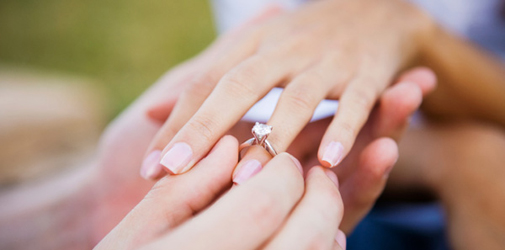
Engagement Ring
Determining a Budget
Selecting a Diamond
For most men, choosing an engagement ring is all about finding the right diamond in a setting that enhances its brilliance and suits its wearer. Famed for their clarity and durability, diamonds come in all shapes and sizes, and making a single choice can be overwhelming.
Diamond Shape
The shape of the diamond you select will come down to personal taste, although bear in mind that different shapes require different settings, which may affect the final appearance of your ring. Choose from a classic and simple round, square or oval shape, or opt for something a little different, such as a pear shape.
The 4C's
The four characteristics that determine the value of a diamond are its cut, clarity, colour and carat.
The cut of the diamond affects its brilliance and how effectively it reflects light. A good cut will be perfect in symmetry, allowing for maximum refraction of light and optimum sparkle.
Clarity refers to the natural markings found on or within the diamond. The fewer the inclusions and blemishes, the better the quality of the diamond. Bear in mind that diamonds come from nature, and very few – if any – are totally free of imperfections.
When appraising the color of white diamonds, the more colourless the diamond, the higher its quality. Diamonds with a cloudy or yellow appearance often attract a lower grade.
Carat simply refers to the weight of the diamond rather than its size. Typically, the cost of a diamond rises with its carat weight, as larger diamonds are more rare, although price also depends on cut, clarity and colour.
Choosing a Diamond Setting
The setting of a diamond determines the style of the ring, and as a result, can be the most confusing aspect of choosing an engagement ring. This is where knowing your fiancée's taste is hugely important. Take a look through her jewellery collection, or ask her friends and family. Think about her usual style; in particular the type of precious metal she prefers (platinum, yellow gold or white gold). It's no easy task deciphering someone's personal taste, but remember that an engagement ring is a gift from you, so it should also reflect your taste.
The Type of Metal
There are three main types of precious metals used in engagement rings: platinum, yellow gold and white gold. Platinum is silver in appearance and the most expensive of the three due to its durability and hypoallergenic qualities that make it so ideally suited to engagement rings. Yellow gold is traditionally the metal of choice for engagement rings as it's less expensive than platinum and more malleable; however, this also makes it more susceptible to wear and tear. White gold is silver in colour and less expensive than platinum. This is also due to its malleability, although it endures slightly better than yellow gold.
The Type of Setting
The timeless and popular solitaire setting focuses the eye solely on the diamond, which is positioned centrally with prongs holding it in place. A side stone setting sees the diamond nestled between smaller diamonds, while the progressively popular three stone setting is said to represent the past, present and future. The tension setting gives the appearance of the diamond floating in its setting through the clever use of pressure. The increasingly common pavé setting incorporates multiple small diamonds into the metal band or frame. The wedding setting refers to matching engagement and wedding rings that are designed to fit together when worn as a pair.













